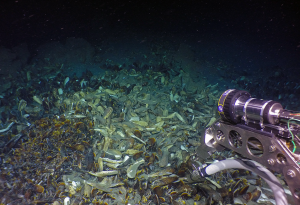Dome View Ports – Best Performance Under Pressure
As seen in the October 2018 issue of ROV Planet.
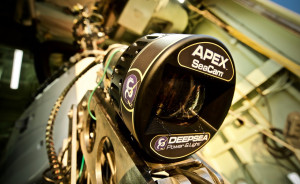
The camera’s view port (or lens port) sits in front of the lens, protecting it from the deep-sea environment. There are two basic types of view ports: dome and flat ports. Both are used in underwater camera housings and are able to withstand high pressure.
Flat view ports are less expensive and easier to implement in an underwater imaging system. Yet for applications that require high quality imaging—from subsea infrastructure inspections to oceanographic research—dome view ports enable a wider field of view, contribute less optical distortion, and maintain higher resolution limits over flat view ports. Additionally, the mechanical properties of dome view ports are better suited to high-pressure environments, giving them an edge when it comes to overall system performance. These advantages make a dome view port an invaluable investment for any operation that relies on top-quality subsea imaging.
Water & Light
It’s no surprise to anyone who works in the subsea industry that light behaves differently underwater than it does in air. Water has what’s called a higher refractive index. This means when light enters water, it bends—refracts—more than it does when traveling through air. The direction the light bends depends on its angle relative to the surface as it passes through. Perpendicular to the optical surface, the light does not refract. The farther away the rays of light are from perpendicular, the more pronounced the refraction.
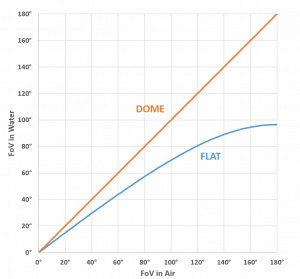
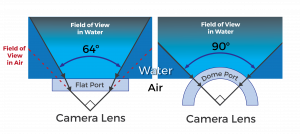
The concentric spherical surfaces on dome view ports are optimal for underwater wide-angle imaging. Rays of light are able to pass perpendicularly through the surfaces of the dome with no refraction, eliminating upper limits on the field of view.
Dome view ports additionally avoid color fringing, or chromatic aberration, a common problem in imaging. When light is refracted, it separates into the color spectrum. The component colors passing from the water through a flat view port travel at different speeds, and are bent at slightly different angles when they reach the lens. This results in imaging that appears to have overlapping colors, blurriness, and “ghosting,” where the different colors do not focus on the same point, creating a copy of the image offset from the rest of the picture.
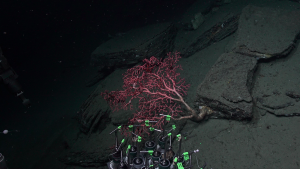
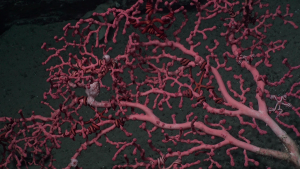
The spherical curvature of dome view ports allows rays from across the field of view to pass through the surfaces without deflection on its way to the lens. The result is a clear image with sharp colors.
There are still significant design challenges to overcome when using a dome view port. From an optical perspective, a dome port forms a “diverging lens” at the front of the camera lens. This moves the focal plane towards the camera, making objects beyond it appear closer than they really are. In some cases, the camera lens can be aligned with the center of curvature of the dome and focused, in water, on the nearer focal plane. In other cases, particularly with varifocal zoom lenses, this is not feasible and a secondary corrector optic is required to push the focal plane back out within the focus limits of the lens. Despite this and other practical issues, a corrected dome port is a superior optical solution and worth the effort.
Water & Light
Beyond the optical advantages, the inherent mechanics of dome view ports are better able to withstand the extreme pressures far below the water’s surface.
Depending on how a force interacts with an object, the object will experience different types of stress. Two types of stress are tension (stretching) and compression (squeezing).
A flat view port spanning a circular opening under hydrostatic pressures experiences local regions of high compressive stress as well as high tensile stress. Dome view ports, on the other hand, resist pressure uniformly outward from the center, resulting in a more even distribution of compressive stress without any tensile stresses.
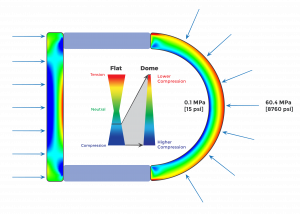
Why is this significant? It comes down to the way that certain materials are more capable of withstanding one type of stress over the other. The transparent materials that are most suitable for high pressure optical ports – glass, sapphire, ceramics – are brittle materials, characterized by exceptional mechanical strength under compression and poor strength under tension. The tensile stresses experienced by flat view ports make them more likely to fracture under pressure, compromising the entire imaging system. Domes are far more resistant to fracture with their more uniform distribution of purely compressive stress.
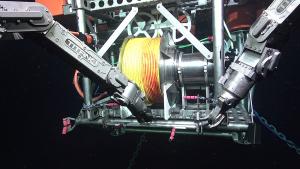
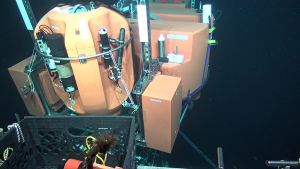
The Importance of Testing
Simply using a dome is not a complete solution; practical concerns such as differences in thermal expansion and in what’s called the Poisson’s ratio between the housing and the dome port can cause localized tensile stresses to build up, forming small cracks and driving them to failure over normal use.
Cyclic pressure testing ensures that a view port design is up to the task of reliably operating thousands of meters below the surface. In cyclic testing, the material is placed in a chamber where it is subjected to varying pressures at repeated intervals. This type of testing accelerates crack formation and growth in brittle materials and will show if a design will withstand the extreme environmental conditions subsea equipment experiences over the course of its usage.
The verdict: dome view ports offer significant advantages over flat view ports for deep-ocean applications. With superior optics and greater reliability, dome ports provide consistently high-quality imaging for even the most demanding subsea applications.
DeepSea Power & Light (DSPL) has over 30 years of experience designing optical solutions for the subsea industry. DSPL rigorously tests its subsea equipment at its in-house facilities at conditions that mirror real-world use, ensuring performance from the surface down to the deep-ocean floor.
